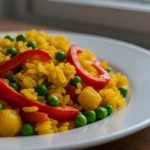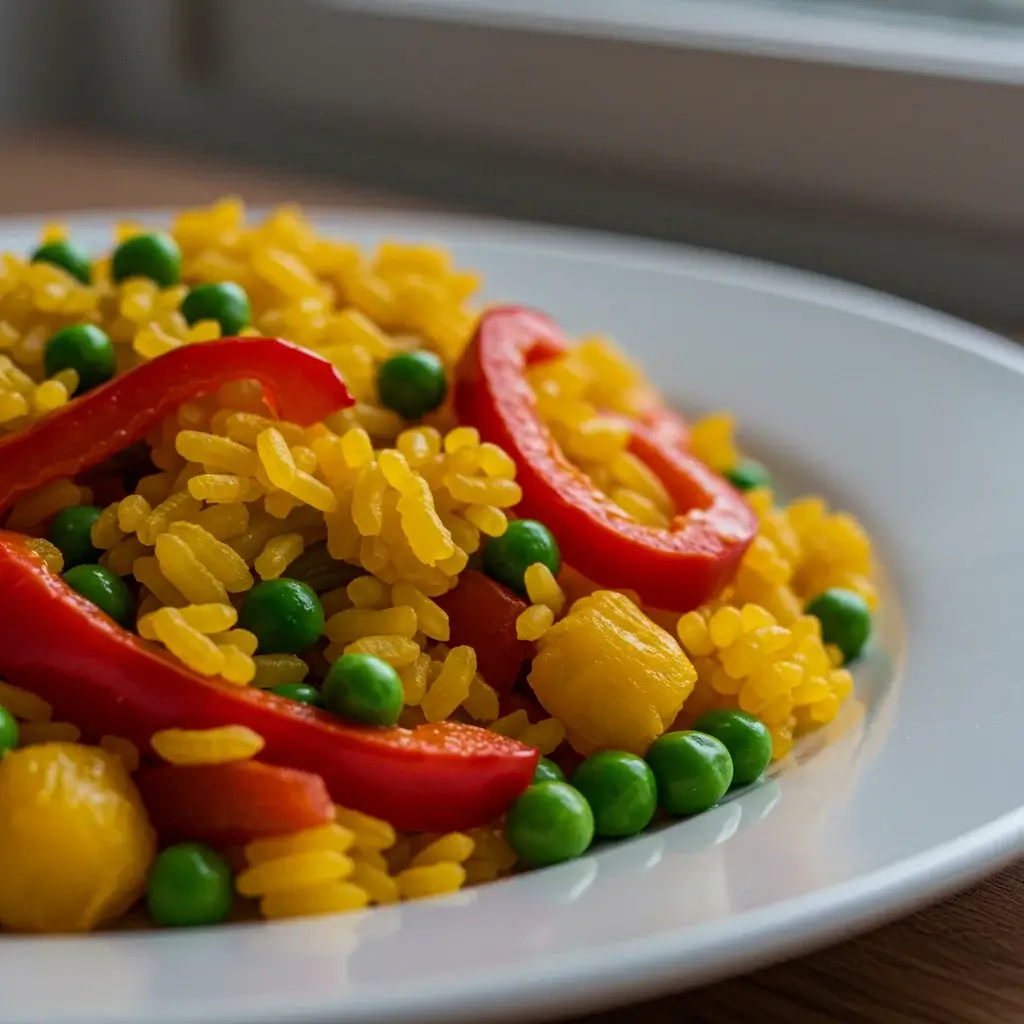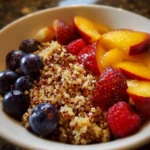Introduction
Vegetable paella is a vibrant, aromatic, and delicious dish that showcases the essence of Spanish cuisine. This saffron-infused delicacy is a vegetarian version of the traditional paella, replacing seafood or meat with a colorful array of vegetables. The combination of bell peppers, peas, and onions with the fragrant saffron creates a symphony of flavors that is both satisfying and healthy. Whether you are a seasoned cook or a novice in the kitchen, this guide will walk you through the process of making the perfect vegetable paella. Let’s dive into the world of Spanish culinary magic!
Ingredients
Creating the perfect vegetable paella starts with gathering the right ingredients. Here’s what you’ll need for this delightful dish:
- 2 cups of Spanish Bomba or Arborio rice
- 4 cups of vegetable broth
- 1 large onion, finely chopped
- 1 red bell pepper, sliced
- 1 yellow bell pepper, sliced
- 1 green bell pepper, sliced
- 1 cup of frozen peas
- 3 cloves of garlic, minced
- 1/2 teaspoon of saffron threads
- 1 teaspoon of smoked paprika
- 1/4 cup of extra virgin olive oil
- Salt and pepper to taste
- 1 lemon, cut into wedges for garnish
- Fresh parsley, chopped for garnish
Instructions
Creating a perfect vegetable paella is an art that requires patience and attention to detail. Follow these steps to master this classic Spanish dish:
- Prepare the Saffron Infusion:
- In a small bowl, add the saffron threads to a few tablespoons of warm vegetable broth. Let it soak for about 10 minutes to release its color and aroma.
- Cook the Vegetables:
- Heat the olive oil in a large paella pan or a wide, flat skillet over medium heat.
- Add the chopped onions and sauté until they become translucent.
- Stir in the garlic and cook for an additional minute.
- Add the sliced bell peppers and cook until they are slightly softened, about 5-7 minutes.
- Add the Rice:
- Stir the rice into the pan, ensuring it is well-coated with the oil and vegetable mixture. Cook for 2-3 minutes to lightly toast the rice.
- Season the Paella:
- Pour in the saffron infusion along with the remaining vegetable broth.
- Add the smoked paprika, salt, and pepper, stirring to combine.
- Simmer the Paella:
- Bring the mixture to a boil, then reduce the heat to a gentle simmer.
- Allow the paella to cook uncovered for about 20 minutes, or until the rice is tender and most of the liquid has been absorbed.
- Add the Peas:
- Stir in the frozen peas during the last 5 minutes of cooking.
- Let It Rest:
- Remove the pan from the heat and cover it with a clean kitchen towel. Let the paella rest for about 5 minutes to allow the flavors to meld.
- Garnish and Serve:
- Garnish with fresh parsley and lemon wedges before serving.
Nutrition Facts
Understanding the nutritional content of your meals is important for maintaining a balanced diet. Here are the nutrition facts for a serving of vegetable paella (approximately 1 cup):
- Calories: 250
- Protein: 5g
- Carbohydrates: 45g
- Fat: 7g
This dish is rich in vitamins and minerals, making it a healthy option for vegetarians and those looking to incorporate more plant-based meals into their diet.
How to Serve
Vegetable paella is a vibrant and flavorful dish that can be enjoyed in various contexts, whether as a hearty main course or as an accompanying side dish. Its versatility allows it to complement a wide array of other foods, making it a perfect choice for gatherings, family dinners, or casual weeknight meals. Here are some expanded serving suggestions to enhance your dining experience with vegetable paella:
As a Main Course
When serving vegetable paella as a main course, it’s important to focus on balancing flavors and textures to create a satisfying meal. Here are some tips:
- Presentation: Serve the paella directly from the pan for an authentic touch, or transfer it to a large serving platter. Garnish with fresh herbs, such as parsley or cilantro, to add a pop of color and freshness. A sprinkle of smoked paprika can also enhance the visual appeal and flavor profile.
- Accompaniments: Pair the paella with crusty bread, such as a fresh baguette or rustic sourdough, to soak up the delicious flavors of the dish. A simple green salad adds a crunchy contrast; consider a mix of arugula, cherry tomatoes, and cucumber dressed with a light vinaigrette. This not only adds freshness but also balances the richness of the paella.
- Citrus Elements: Provide lemon wedges on the side, allowing guests to squeeze fresh juice over their servings. The acidity of the lemon brightens the saffron and enhances the vegetable flavors, making each bite more vibrant.
- Beverage Pairing: Complement the meal with a light white wine, such as a Spanish Albariño or a crisp Sauvignon Blanc. For non-alcoholic options, consider serving a refreshing sparkling water with a slice of lemon or a homemade citrus-infused iced tea.
As a Side Dish
When vegetable paella is served as a side dish, it can elevate the overall meal while providing a burst of flavor. Here’s how to incorporate it effectively:
- Pairing with Proteins: Vegetable paella pairs beautifully with grilled meats or seafood. Consider serving it alongside marinated grilled chicken, succulent shrimp skewers, or even a juicy steak. The smoky flavors from the grill will complement the earthiness of the paella, creating a harmonious dish.
- Spanish Tapas Spread: For a delightful tapas experience, serve the paella alongside other Spanish small plates. Dishes such as patatas bravas (spicy potatoes), pan con tomate (tomato bread), and olives can create a diverse and satisfying spread. This allows guests to mix and match flavors, enhancing the overall dining experience.
- Vegetarian and Vegan Options: If you’re hosting vegetarians or vegans, consider expanding your menu to include additional plant-based dishes. Grilled vegetables, chickpea salad, or a zesty gazpacho can create a colorful and varied table that highlights the versatility of Mediterranean cuisine.
- Family-Style Serving: For a casual dining experience, consider serving the paella family-style in a large bowl, allowing guests to help themselves. This approach encourages sharing and conversation, making the meal feel more communal and relaxed.
- Garnishes and Finishing Touches: Enhance the flavor of the dish with additional garnishes, such as a drizzle of high-quality extra virgin olive oil or a sprinkle of fresh herbs just before serving. A dash of chili flakes can add a touch of heat for those who enjoy a little spice.
By thoughtfully considering how to serve vegetable paella, you can create a memorable dining experience that showcases the dish’s versatility and deliciousness. Whether enjoyed as a main course or a side dish, vegetable paella will surely impress your guests and leave them craving more.
Additional Tips
To truly elevate your vegetable paella and ensure it is a memorable dish, consider incorporating the following detailed tips. These recommendations will help you achieve authentic flavors and textures while allowing you to personalize your paella to suit your taste preferences.
Use High-Quality Saffron
Saffron is the hallmark of any traditional paella, imparting both an exquisite golden hue and a unique, aromatic flavor that distinguishes it from other rice dishes. When selecting saffron, it is essential to choose high-quality threads over powdered saffron, as the latter often contains additives and lacks the full flavor profile. Look for saffron that is deep red in color, with long, thin threads, and consider purchasing from reputable sources or specialty spice shops. To maximize its impact, soak the saffron threads in a small amount of warm water or broth for about 10-15 minutes before adding them to your paella. This not only enhances the infusion of flavor but also ensures that the vibrant color is evenly distributed throughout the rice.
Avoid Stirring
One of the defining characteristics of traditional paella is the technique used during cooking. A crucial tip to remember is to avoid stirring the rice once the liquid has been added to the pan. This practice allows the rice to cook evenly while forming the coveted socarrat, a crispy, caramelized layer of rice at the bottom of the pan. To achieve the perfect socarrat, ensure that your heat is adjusted properly; you may start with a high flame to bring the liquid to a boil and then lower it to a gentle simmer. Keep a close eye on the cooking process in the final stages, as you want to hear a gentle crackling sound that indicates the socarrat is forming. Once done, allow the paella to rest for about 5-10 minutes off the heat before serving; this will help set the socarrat and improve the overall texture of the dish.
Experiment with Vegetables
Vegetable paella is incredibly versatile, allowing you to tailor the ingredient list based on seasonal availability or personal preference. While traditional recipes may call for specific vegetables, don’t hesitate to experiment with various options. For instance, you can incorporate seasonal favorites such as asparagus, bell peppers, or peas for added color and nutrition. Artichokes, zucchini, and mushrooms not only enhance the flavor profile but also provide different textures that complement the rice. Additionally, consider using roasted or grilled vegetables to add a smoky depth to the dish. Remember to cut your vegetables into bite-sized pieces to ensure even cooking and a harmonious blend of flavors.
Broth Matters
The broth you choose to use can make a significant difference in the overall taste of your vegetable paella. Opting for a flavorful vegetable broth instead of plain water will provide a richer base for your dish. If time permits, consider making your own broth using vegetable scraps, herbs, and spices simmered for several hours. This homemade broth can encapsulate the essence of your chosen vegetables and contribute a depth of flavor that store-bought options often lack. If you do use store-bought broth, look for low-sodium versions to control the saltiness of your dish while still infusing it with ample flavor. Additionally, enhancing your broth with spices such as smoked paprika, bay leaves, or a dash of white wine can elevate the taste further, making your vegetable paella truly exceptional.
By following these enhanced tips, you can create a vegetable paella that not only pays homage to its traditional roots but also allows you to express your culinary creativity. With high-quality ingredients and careful attention to technique, your paella will be a flavorful centerpiece that delights your guests and showcases the vibrant essence of this iconic Spanish dish.
FAQs
1. Can I make vegetable paella ahead of time?
Yes, vegetable paella can be made ahead of time and stored in the refrigerator for up to three days. Reheat it gently on the stove or in the microwave before serving.
2. Can I freeze vegetable paella?
While you can freeze paella, it’s important to note that the texture of the rice may change upon thawing. For best results, consume it fresh or within a few days if refrigerated.
3. Is it possible to make paella without saffron?
While saffron is a key ingredient that gives paella its distinctive flavor and color, you can substitute it with turmeric for color. However, the flavor will differ slightly.
4. What type of rice should I use for paella?
For authentic paella, use Spanish Bomba rice or Arborio rice. These types of rice absorb liquid well and maintain their texture during cooking.
Conclusion
Vegetable paella is a vibrant celebration of Spain’s diverse culinary heritage, encapsulating the essence of Mediterranean cooking through its bold flavors, colorful presentation, and wholesome ingredients. Rooted in the traditions of Valencia, where the original paella was created, this dish represents not only a meal but a cultural experience that brings people together around the table. The marriage of saffron, a prized spice that imparts a golden hue and aromatic depth, with an array of fresh vegetables, creates a dish that is as visually stunning as it is delicious.
One of the unique aspects of vegetable paella is its versatility. While traditional recipes often incorporate meat or seafood, the vegetarian version showcases the incredible variety of seasonal vegetables that can be used. From sweet bell peppers and tender green beans to artichokes and peas, the possibilities are endless. This adaptability allows home cooks to personalize the dish according to their preferences or the vegetables available in their region, making it a perfect option for celebrating local produce. The use of high-quality ingredients, such as organic vegetables and artisanal rice, elevates the dish and enhances its flavor profile, ensuring that every bite is a delight.
Moreover, vegetable paella is not just a feast for the palate; it is also a health-conscious choice. Packed with vitamins, minerals, and fiber from the vegetables, it provides a nutritious alternative to heavier meat-based dishes. The inclusion of olive oil, a staple in Mediterranean diets, adds heart-healthy fats, while saffron is known for its antioxidant properties. This makes vegetable paella a suitable option for a variety of dietary preferences, whether you’re a health-focused individual, a vegetarian, or simply someone looking to incorporate more plant-based meals into their diet.
When it comes to serving, vegetable paella can shine in various settings. As a main course, it stands proudly at the center of the table, inviting guests to serve themselves and savor the communal aspect of sharing food. It can also be served as a side dish, complementing grilled meats or seafood at a summer barbecue or festive gathering. The dish can be enjoyed warm or at room temperature, making it a convenient choice for potlucks and picnics.
To create the perfect vegetable paella, it’s essential to follow a few key steps that will enhance the overall outcome. Start by selecting the right type of rice—Bomba or Calasparra rice are preferred for their ability to absorb flavors while retaining a firm texture. The layering of flavors begins with sautéing aromatic ingredients such as onions, garlic, and tomatoes, which form a rich base. Adding the saffron-infused broth gradually ensures that the rice cooks evenly and absorbs the vibrant hues and flavors of the vegetables.
As you gather your ingredients and embark on the cooking process, remember that making vegetable paella is not just about following a recipe; it’s about embracing the spirit of Spanish cuisine. Enjoy the process of cooking, allow yourself to experiment with different vegetables, and take pride in the final presentation. A sprinkle of fresh parsley or a squeeze of lemon can elevate the dish even further, adding a bright finish that enhances its appeal.
In conclusion, vegetable paella is much more than just a dish; it is an experience that encapsulates the warmth of Spanish hospitality and the joy of sharing a meal with loved ones. It invites you to explore the culinary traditions of Spain while creating a nourishing and satisfying meal that everyone can enjoy. So, gather your ingredients, follow the steps, and immerse yourself in the rewarding experience of making this classic Spanish dish. Happy cooking, and may your kitchen be filled with the delightful aromas that only a homemade paella can bring!
Print
Vegetable Paella (Saffron-Infused)
Ingredients
Creating the perfect vegetable paella starts with gathering the right ingredients. Here’s what you’ll need for this delightful dish:
- 2 cups of Spanish Bomba or Arborio rice
- 4 cups of vegetable broth
- 1 large onion, finely chopped
- 1 red bell pepper, sliced
- 1 yellow bell pepper, sliced
- 1 green bell pepper, sliced
- 1 cup of frozen peas
- 3 cloves of garlic, minced
- 1/2 teaspoon of saffron threads
- 1 teaspoon of smoked paprika
- 1/4 cup of extra virgin olive oil
- Salt and pepper to taste
- 1 lemon, cut into wedges for garnish
- Fresh parsley, chopped for garnish
Instructions
Creating a perfect vegetable paella is an art that requires patience and attention to detail. Follow these steps to master this classic Spanish dish:
- Prepare the Saffron Infusion:
- In a small bowl, add the saffron threads to a few tablespoons of warm vegetable broth. Let it soak for about 10 minutes to release its color and aroma.
- Cook the Vegetables:
- Heat the olive oil in a large paella pan or a wide, flat skillet over medium heat.
- Add the chopped onions and sauté until they become translucent.
- Stir in the garlic and cook for an additional minute.
- Add the sliced bell peppers and cook until they are slightly softened, about 5-7 minutes.
- Add the Rice:
- Stir the rice into the pan, ensuring it is well-coated with the oil and vegetable mixture. Cook for 2-3 minutes to lightly toast the rice.
- Season the Paella:
- Pour in the saffron infusion along with the remaining vegetable broth.
- Add the smoked paprika, salt, and pepper, stirring to combine.
- Simmer the Paella:
- Bring the mixture to a boil, then reduce the heat to a gentle simmer.
- Allow the paella to cook uncovered for about 20 minutes, or until the rice is tender and most of the liquid has been absorbed.
- Add the Peas:
- Stir in the frozen peas during the last 5 minutes of cooking.
- Let It Rest:
- Remove the pan from the heat and cover it with a clean kitchen towel. Let the paella rest for about 5 minutes to allow the flavors to meld.
- Garnish and Serve:
- Garnish with fresh parsley and lemon wedges before serving.
Nutrition
- Serving Size: one normal portion
- Calories: 250
- Fat: 7g
- Carbohydrates: 45g
- Protein: 5g






